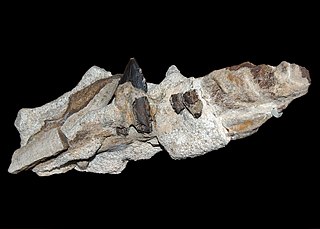
Tanyderidae, sometimes called primitive crane flies, are long, thin, delicate flies with spotted wings, superficially similar in appearance to some Tipulidae, Trichoceridae, and Ptychopteridae. Most species are restricted in distribution. They are found in many parts of the world, including North America, South America, Africa, Australia, New Zealand, and various islands in the Pacific Ocean. Adults are usually found hanging from vegetation near streams. Larvae are found either in sandy stream margins or in wet, rotten wood. Fossil species are known.
Nannochoristidae is a family of scorpionflies with many unusual traits. It is a tiny, relict family of about eight species, with members occurring in New Zealand, southeastern Australia, Tasmania, and Chile. Due to the groups distinctiveness from other scorpionflies, it is sometimes placed in its own order, the Nannomecoptera. The adults look like scorpionflies with more pointed, elongated wings. Most mecopteran larvae are eruciform, or shaped like caterpillars. Nannochoristid larvae, however, are elateriform, or shaped like wireworm or click beetle larvae. They are also the only entirely aquatic Mecoptera. Wing venation suggests a close relationship to dipterans. They are predatory, primarily on the larvae of aquatic Diptera.

Allopleuron is a genus of extinct sea turtle, which measured 2-to-2.5-metre long in life. The type species is Allopleuron hofmanni. It is a basal member of the clade Pancheloniidae, closely related to Protosphargis. Similar to Protosphargis, it was characterized by shell reduction.

Sagenopteris is a genus of extinct seed ferns from the Triassic to late Early Cretaceous.
Alexandrinia is an extinct genus of mayflies which existed in what is now Russia and the United States during the Permian period. It was described by N. D. Sinitshenkova and D. V. Vassilenko in 2012, and contains four species: A. gigantea, A. directa, A. ipsa and A. vitta.
Misthodotes is an extinct genus of mayflies which existed during the Permian of what is now the United States and Russia. It was described by E.H. Sellards in 1909. A new species, M. tshernovae, was described from the Upper Permian epoch of Russia by N. D. Sinitshenkova and D. V. Vassilenko in 2012.

Patriocetus is an extinct genus of toothed whale.
Dysoneuridae is an extinct family of insect in the order Trichoptera, the caddisflies. The family was first described by I.D. Sukacheva in 1968, and lived in the Mesozoic era between 164.7 mya to 125.45 mya. Members of this family lived in lagoons, ponds, and terrestrial habitats.
Permosynidae is a family of Protocoleopteran beetle in the superfamily Permosynoidea. The family lived between the Late Permian and Late Jurassic and lived in Russia and Mongolia. Species that were discovered in 2014 include Artematopodites latissimus, Platycrossos latus, Platycrossos longus, Platycrossos loxonicus, Platycrossos mongolicus, Platycrossos ovum and Dzeregia platis. Species that were discovered in 2015 include Artematopodites lozowskii and Dinoharpalus latus.
Platycrossos is a genus of Protocoleopteran beetle in the family Permosynidae. Fossils of this genus have been recovered from Late Jurassic sediments in Mongolia. It contains the following species:
Acodus is an extinct genus of conodonts.
Cordylodus is an extinct genus of conodonts in the family of Cordylodontidae.
Liadotaulius is an extinct genus of caddisflies. It is currently (tentatively) placed in the family Philopotamidae, though it has previously been placed in the extinct families Necrotauliidae and Dysoneuridae.
Palaeoludus is an extinct genus of caddisflies in the family Dysoneuridae. It contains only one species, Palaeoludus popovi. The genus is known from the lower Cretaceous of southern England.
Prochita is an extinct genus of caddisflies in the family Dysoneuridae. It contains only one species, Prochita rasnitsyni. The genus is known from the Upper Jurassic—Lower Cretaceous of the Transbaikal region of Russia.

The Bukachacha Formation is a geological formation in Zabaykalsky Krai, Russia dating to the Early Cretaceous (Barremian). The tuffaceous mudstones of the formation were deposited in a lacustrine environment.

Necrotauliidae is an extinct family Mesozoic Amphiesmenoptera. While previously considered a paraphyletic grouping of "basal Trichoptera, basal Lepidoptera, and advanced stem-Amphiesmenoptera", they have recently been considered early diverging caddisflies.
Lithax is a genus of caddisflies belonging to the family Goeridae.

Orthophlebiidae is an extinct family of scorpionflies known from the Triassic to Cretaceous, belonging to the superfamily Panorpoidea. The family is poorly defined and is probably paraphyletic, representing many primitive members of Panorpoidea with most species only known from isolated wings, and has such been considered a wastebasket taxon.
Protorthophlebia is an extinct genus of scorpionflies, known from the Triassic and Jurassic periods of Eurasia. It was originally considered a member of the family Orthophlebiidae, but was later placed as the only genus within the family Protorthophlebiidae within the superfamily Panorpoidea.






